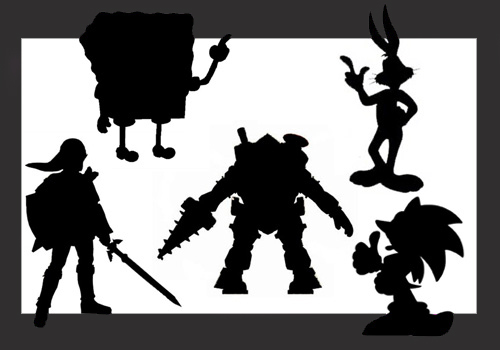One of the more famous paraphrases in cartooning is one that Matt Groening of the Simpson’s fame made. It’s about how you can gauge the strength of your character design by being able to distinguish your characters even from a silhouette. That is to say even with no details just the shape of the character should make its identity known. I’ve always liked that concept. And though I can’t say that all my character designs have stood up to the silhouette test that bit of advice is always in the back of my mind.
Of course as writers we don’t have a silhouette test. We’re not a visual medium, so unless you’re a weirdo like me who draws all the characters in a novel for fun, there is not a ‘character design’ as there is in visual media. Granted this could be greatly debated. As many an author spends more time thinking about how a character looks and moves than his or her political leanings. But, even still we don’t have the same kind of silhouette sort of deal that Groening referred to on the writing page. Though I do feel we have a similar track to gauge when we go about developing characters.
The voice you give your character plays that same role. The idea is relatively the same, and stands up to a certain iconography that the silhouette test does in cartooning. The question however becomes, can you distinguish your character from his or her dialog alone?
Obviously we’ve all read a novel before where every character talks the same. Mostly this appears to be exactly in the same voice as the narration. This can both be annoying and it can get confusing, especially when two people who sound exactly the same get into a conversation. Of course most writers who have any skill in their craft spend a lot of time dreaming up characters. They give them personalities, which are different. They have different moods, and come from different places. These things are usually enough to give a variance to the speech patterns, slang, and even patterns of how they ‘speak’ on the page. However, are they purely distinguishable from different character archetypes, or are they unique in their speaking? And more importantly we must ask how we make our characters sound different. How do we distance our characters from our own writing voice to make them pronounced? And how do we discover for them a voice that is all their own?
When we were in grade school we all learned about “voice” in writing. We were taught how a narrative voice sets a setting and a mood. This simple concept can also be borrowed into characters. When you think about your character’s personality and how others act towards them, does the voice reflect that? When you think about how you and your readers feel about a character can you bring these emotions to his or her voice? The voice can be reflective of history, and also be reflective of mood and tension. These small things when delivered as the characters voice pushes home a lot of the feelings and emotions you may want to convey in a way that might be hard to illustrate with prose alone. It’s a strong tool, and by delivering a strong mood for a character, you can deliver a realistic character that will strike home with the reader. If you’re worried about guiding emotional impact, a well-chosen voice can help push these concepts to the reader in a way that might even seem undetectable when reading a characters voice. Voice becomes a great way to “show don’t tell” in your writing. It both delivers the emotion needed and also gives a uniqueness to your character that is completely your own and delivers an individual more than just a archetype.
Often I find when developing characters, I find myself also coming up with an actual spoken voice that matches the character. This both helps me float right into the character as though I am acting, but it also gives me more material in my mind as I’m writing. I like to think about the tones of the voice, the accent they may have and characterizations of the voice. When I write about a character with a ‘deep nasally voice’ I write the dialog in a way that feels fluid with that sort of voice. It’s important not just to say the character of a voice but to also allow it to easily fill that role. And though it might seem silly, a guy with a nasally voice can speak any word as a guy with a deep resonating voice, chosen words might sound better coming from one than the other.
Obviously there are a lot of ways to go about looking at a character in terms of his or her voice, the character and texture. I’ve only mentioned a few, and it’s only the tip of the iceberg so to speak.
Honestly it takes a lot of thought to really understand how the voice of your character should be. It seems sometimes to be a secondary thing, like hair colour or something. But voice can really make your characters stand out and deliver who he or she is. The extra time is well worth it, and with a strong voice you will have a strong character, nay a strong person.
